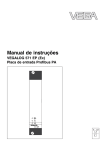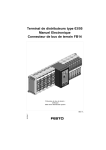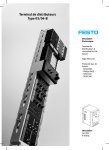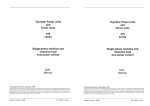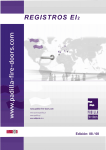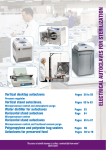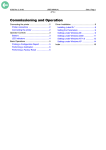Download Operating Instructions ERM Control Unit
Transcript
Operating instructions ZF Electronic Control Unit ERM 6057 758 101b Subject to alterations in design Copyright by ZF The present documentation is protected by copyright. Any kind of reproduction or dissemination in whatever form that does not exclusively correspond to documentation objectives will be prosecuted if no prior approval by ZF Friedrichshafen AG was granted. Printed in Germany ZF Friedrichshafen AG, MC-C / 2001-03 Issue: 2005-02 Safety instructions The following safety instructions appear in this manual: Companies repairing ZF units are responsible for their own work safety. NOTE Refers to special processes, techniques, data, use of auxiliary equipment, etc. To avoid injury to personnel and damage to products, all safety regulations and legal requirements which apply to repair and maintenance work must be adhered to. Before starting work, mechanics must familiarize themselves with these regulations. CAUTION This is used when incorrect, unprofessional working practices could damage the product. Personnel required to carry out repairs on ZF products must receive appropriate training in advance. It is the responsibility of each company to ensure that their repair staff is properly trained. 6057 758 101 - 2005-02 ! 3 DANGER This is used when lack of care could lead to personal injury or death. General Information Read this manual carefully before starting any tests or repair work. CAUTION Pictures, drawings and components do not always represent the original object, but are used to illustrate working procedures. Pictures, drawings and components are not to scale. Conclusions about size and weight should not be drawn (even within a complete illustration). Always follow the working steps as described in the text. After completion of repair work and testing, skilled staff must satisfy themselves that the product is functioning correctly. 6057 758 101 - 2005-02 4 Table of contents 1 1.1 1.2 1.3 1.4 1.5 Technical data . . . . . . . . . . . . . . . . . . . . . . . . . . . 6 Technical data, installation dimensions . . . . . . . 6 Circuit board removal and installation . . . . . . . . 8 Circuit board configuration . . . . . . . . . . . . . . . . . 10 Pin assignment . . . . . . . . . . . . . . . . . . . . . . . . . . . 12 Summary of pin assignment . . . . . . . . . . . . . . . . 14 2 2.1 2.2 2.3 Description . . . . . . . . . . . . . . . . . . . . . . . . . . . . . General configuration . . . . . . . . . . . . . . . . . . . . . Coding clutch / brake . . . . . . . . . . . . . . . . . . . . . Controller for transfer function . . . . . . . . . . . . . . 16 16 18 19 3 3.1 Operating modes . . . . . . . . . . . . . . . . . . . . . . . . . Operating mode “open loop (current)” . . . . . . . . 3.1.1 Function diagram . . . . . . . . . . . . . . . . . . . 3.1.2 Pin assignment . . . . . . . . . . . . . . . . . . . . . 3.1.3 Technical instructions . . . . . . . . . . . . . . . . 3.1.4 Startup . . . . . . . . . . . . . . . . . . . . . . . . . . . . Operating mode “open loop (torque)” . . . . . . . . . 3.2.1 Function diagram . . . . . . . . . . . . . . . . . . . 3.2.2 Pin assignment . . . . . . . . . . . . . . . . . . . . . 3.2.3 Technical instructions . . . . . . . . . . . . . . . . 3.2.4 Startup . . . . . . . . . . . . . . . . . . . . . . . . . . . . Operating mode “controlled with Ø sensing” . . . 3.3.1 Function diagram . . . . . . . . . . . . . . . . . . . 3.3.2 Pin assignment . . . . . . . . . . . . . . . . . . . . . 3.3.3 Technical instructions . . . . . . . . . . . . . . . . 3.3.4 Startup . . . . . . . . . . . . . . . . . . . . . . . . . . . . 20 20 20 21 22 22 23 23 24 25 25 26 26 27 28 28 3.2 3.3 6057 758 101 - 2005-02 3.4 3.5 3.6 4 5 Operating mode “controlled with Ø calculation” 3.4.1 Function diagram . . . . . . . . . . . . . . . . . . . 3.4.2 Pin assignment . . . . . . . . . . . . . . . . . . . . . 3.4.3 Technical instructions . . . . . . . . . . . . . . . . 3.4.4 Startup . . . . . . . . . . . . . . . . . . . . . . . . . . . . Operating mode “closed-loop control” . . . . . . . . 3.5.1 Function diagram . . . . . . . . . . . . . . . . . . . 3.5.2 Pin assignment . . . . . . . . . . . . . . . . . . . . . 3.5.3 Technical instructions . . . . . . . . . . . . . . . . 3.5.4 Startup . . . . . . . . . . . . . . . . . . . . . . . . . . . . Additional functions max-power / zero-power . 30 30 31 32 33 34 34 35 36 36 37 Identification and causes of failure / corrective action . . . . . . . . . . . . . . . . . . . . . . . . . 38 Technical Data 1 Electronic control unit ERM Technical data 1.1 Technical data, installation dimensions Nominal direct voltage for ZF hysteresis clutches and brakes at nominal torque and a coil temperature of 120 °C: 30 V DC Permissible residual ripple: 1.5 V Operating voltage range: 24 V to 36 V DC Open circuit power consumption: Ambient temperature: 0 to + 50 °C Storage temperature: -30 to + 70 °C Humidity class: DIN IEC 68, part 2-30 < 150 mA Safety class according to DIN 40 050: IP 30 Maximum current input: (depending on unit size) 2.8 A Rack: 19” 7 TE plug-in module Connection: 18-pin pull-off screw-type Fuse: fine-wire fuse 4A medium time-lag fuse Voltage output: 10 V = + / – 0.8 V 20 mA (R a min = 500 Ω) Weight: Frequency input: input resistance R E ≥ 3.3 k Ω NOTE The screw-type terminal block is not suitable for bus assembly. Make sure that connecting cables are long enough or that the screw-type terminal block on the rear of the assembly rack is accessible. terminal (within the scope of supply) Switching threshold “low” to “high” > 11.5 V DC Switching threshold “high” to “low” < 4.0 V DC 6057 758 101 - 2005-02 6 0.6 kg Electronic control unit ERM Technical Data Installation dimensions 182.5 111.5 128 015242 6057 758 101 - 2005-02 7 92 170 35 Technical Data Electronic control unit ERM Installation: 1. Carefully insert board into rack, guiding slot without tilting. 1.2 Circuit board removal and installation Removal: 1. Switch off operating voltage. 2. Tighten screws (1 + 4) so that the cooling attachment on the board contacts the metal rack and thus ensures optimum heat dissipation. CAUTION If the operating voltage is not switched off, product and system can be damaged. NOTE Do not exceed permissible tightening torque to avoid board damage. 2. Remove terminal strip (2) from plug connector (3). 3. Remove screws (1 + 4). 3. Make sure that operating voltage is switched off. 4. Carefully pull board out of the rack without tilting. CAUTION If the operating voltage is not switched off, product and system can be damaged. 4. Introduce terminal strip (2) into plug connector (3). CAUTION Contacts must not be damaged, otherwise perfect functioning of the system is not ensured. 6057 758 101 - 2005-02 8 Electronic control unit ERM Technical Data 1 2 3 4 015239 6057 758 101 - 2005-02 9 Technical Data Electronic control unit ERM 1.3 Circuit board configuration Designation Function LED (1) “Power” Supply voltage is applied and ERM program is ready. LED (2) “Feedb.” Closed-loop control operating mode, i.e. DIL switch position 5 and 6 = “1”. LED (3) “Ø-Contr.” • Ø sensing operation, DIL switch position 5 = “1” and 6 = “0” or • Ø calculation operation, DIL switch position 5 = “0” and 6 = “1”. • LED “Ø-Contr.” flashes, if the setting procedure has not been carried out in the operating mode Ø calculation or Ø sensing. Connection for diagnostic unit Diagnostic connector for ZF MOBiDIG tester K-cable, acc. to ISO 9141 Jumper For function selection. e.g. feed rate interruption, emergency brake Fuse Fine-wire fuse 4 A, medium time-lag fuse DIL switches Setting of various operating modes and unit sizes Program memory Includes microprocessor operating program Data memory Contains operating parameters Terminal strip 18-pin 6057 758 101 - 2005-02 10 Electronic control unit ERM Program memory DIL switches Technical Data Cooling attachement Fuse 1 2 3 1 2 3 4 5 6 7 8 OPEN 017182 Connection for diagnostic unit 6057 758 101 - 2005-02 Microprocessor Jumper 11 Data memory E2PROM Terminal strip Technical Data Electronic control unit ERM 1.4 Pin assignment +24 V to +36 V Stop Set 17 18 11 fv PNP 10 fn PNP 1 2 3 4 5 6 7 8 16 12 OPEN 13 10 k 10 k 7 1 2 3 9 Soll 5 6 Jumper 8 Ist 1 14 2 15 015241 7 Example for external analog input, e.g. SPS + – 14 9 5 Alternative function Web tear recognition PIN 17, 18 (+24 V to +36 V) 8 6057 758 101 - 2005-02 15 12 Electronic control unit ERM Technical Data NOTE The electronic control unit does not require the potentiometer to fulfill any particular requirements. However, mechanical requirements regarding installation need to be considered. Recommendations for potentiometer: Resistance value: 1 kΩ - 47 kΩ Type: magnetoresistive potentiometer, for voltage input nom. value also wire potentiometer can be used. Jumper-Position: Appropriate function is activated by inserting a jumper. 1 ● ● 2 ● ● 3 ● ● as supplied: standard functions, tear recognition, friction compensation terminal 14: current zero function; terminal 15; current max. function terminal 8: Ø actual 0 - 5 V, instead of 0 - 10 V NOTE Pos. 1 and 2 must never be connected simultaneously. 6057 758 101 - 2005-02 13 Technical Data 1.5 Electronic control unit ERM Summary of pin assignment PIN Function 1 ground (–) 2 ground (–) 3 no assignment 4 no assignment 5 analog ground 6 current return cable (measurement input) clutch / brake max. 2.55 A (depending on unit size) 7 voltage output 10 V ± 0.8 V DC max. load 20 mA; load impedance R a min = 500 Ω 8 PIN voltage input, actual value (0 to + 10 V) input resistance R i = 200 k Ω; Input may also be supplied by external analog sources, provided the voltage refers to ground (PIN 5) and the max. value does not exceed + 10 V. 6057 758 101 - 2005-02 14 Function 9 voltage input, nominal value (0 to +10 V) input resistance R i = 200 kΩ ; Input may also be supplied by external analog sources, provided the voltage refers to ground (PIN 5) and the max. value does not exceed + 10 V. 10 digital input “stop” input resistance 4.7 kΩ ; input current 5 to 8 mA;* Umax = operating voltage Function is maintained as long as the signal is on. 11 digital input “set” (push-button) input resistance 4.7 kΩ ; input current 5 to 8 mA;* U max = operating voltage 12 frequency input - fn (roller speed) frequency 3 to 1000 Hz; input resistance 3.3 kΩ pulse ≥ 0.5 ms, interpulse period ≥ 0.5 ms input resistance 3.3 kΩ Electronic control unit ERM Technical Data PIN Function 13 PIN Function frequency input - fv (feedrate) frequency 3 to 1000 Hz; input resistance 3.3 kΩ pulse ≥ 0.5 ms, interpulse period ≥ 0.5 ms input resistance 3.3 kΩ 14 output roller speed output voltage 24 V DC; max. load 50 mA; max. load impedance 10 kΩ ; A suppressor diode must be used with inductive load (no varistor !) input current - zero load current 1 to 2 mA;* For functions consult relevant operation mode. Function is maintained as long as the signal is on. 15 output feedrate output voltage 24 V DC; max. load 50 mA; max. load impedance 10 kΩ ; A suppressor diode must be used with inductive load (no varistor !) input current - max. load current 1 to 2 mA;* For functions consult relevant operation mode. Function is maintained as long as the signal is on. 6057 758 101 - 2005-02 16 current output clutch / brake max. 2.55 A (depending on unit size) NOTE: Limit for EBU 2000! 17 voltage supply + 24 V to + 36 V max. current 2.8 A (depending on unit size) 18 voltage supply + 24 V to + 36 V max. current 2.8 A (depending on unit size) * NOTE Gold-plated contacts are recommended for pushbutton, switch and relais. 15 Description 2 Electronic control unit ERM • Operating mode “open-loop control (torque)” The DIL switches must be set to suit unit size (Y Y Y Y) (see page 18). Torque is set and kept constant in accordance with the nominal value input. Hereby, the interdependence of the nominal voltage value/torque is subject to approximate linear distribution. Description 2.1 General configuration The ZF electronic control unit ERM can control ZF hysteresis clutches and brakes in different operating modes, as required by the application. The ERM is controlled by a microprocessor and features programming, operation and diagnosis interfaces. The ERM is designed for optimum supply of the ZF hysteresis clutches EKU and the ZF hysteresis brakes EBU. Controlled operating modes with size coding are less suitable for performance optimized brake range. Operating mode “open-loop control (torque)” 1 2 3 4 5 6 7 8 DIL switch Y Y Y Y 0 0 . • Operating mode “controlled with Ø sensing” The DIL switches must be set to suit unit size (Y Y Y Y) (see page 18). Setting procedure: • sense maximum roller Ø • push set key • release set key (reference value for max. Ø is accepted). The DIL switches enable the following operating modes to be set: • Operating mode: “open-loop control (current)” This operating mode is set by the manufacturer, i.e. it is not necessary to change the DIL switch positions. Current is set and kept constant in accordance with the nominal value input. NOTE Data are stored in non-volatile memory; data are not erased when the supply voltage is switched off. Operating mode “open-loop control (current)” 1 2 3 4 5 6 7 8 DIL switch 0 0 0 0 0 0 0 0 as supplied 6057 758 101 - 2005-02 . Unit size - coding (characteristic) 16 Electronic control unit ERM Description The reference value for the max. Ø is not erased when the supply voltage is switched off. It can therefore be used when the ERM is fitted, i.e. it can be stored in E 2PROM. The stored reference value is deleted when another operating mode is selected (“open-loop control” or “closed loop control”). Production speed and nominal traction may be altered even during operation. NOTE If a frequency < 3 Hz is already reached during a setting procedure, no reference values will be transferred (LED 3 continues flashing). Frequency range 3 - 1000 Hz. Stored reference values are deleted when another operating mode is selected (“open-loop control” or “closed loop control”). • release set key (reference values for max. Ø is accepted). Operating mode “controlled with Ø sensing” 1 2 3 4 5 6 7 8 DIL switch Y Y Y Y 1 0 . Production speed and nominal traction may be altered even during operation. . Unit size - coding (characteristic) Operating mode “controlled with Ø calculation” • Operating mode: “controlled with Ø calculation” The DIL switches must be set to suit unit size (Y Y Y Y) (see page 18). Setting procedure: • approach maximum roller Ø • push set key when production speed is reached 6057 758 101 - 2005-02 1 2 3 4 5 6 7 8 DIL switch Y Y Y Y 0 1 . 17 . Unit size - coding (characteristic) Description Electronic control unit ERM • Operating mode “closed-loop control” The DIL switches must be set to suit unit size (Y Y Y Y) (see page 18). PD, PI and PID are available for position-and-force closed-loop control. The I portion can be blocked by stop input. Thus, the last controlled torque is maintained when the unit is stopped. Coding DIL switch 1 1 0 1 0 1 0 1 0 1 0 1 0 1 0 1 0 0 1 0 0 Operating mode “closed-loop control” 1 2 3 4 5 6 7 8 DIL switch Y Y Y Y 1 1 0 0 PD for position control Y Y Y Y 1 1 1 0 PI for force control e.g. with mech. compensator Y Y Y Y 1 1 1 1 PI for force control e.g. with no-travel tension sensor or freely programmable Y Y Y Y 1 1 0 1 PID for position or force control 2.2 Coding clutch / brake NOTE With DIL switches 1- 4, the ERM control unit can be set to the corresponding clutch or brake. 6057 758 101 - 2005-02 18 2 0 1 1 0 0 1 1 0 0 1 0 1 1 0 0 1 0 0 1 1 3 0 0 0 1 1 1 1 0 0 0 0 0 0 1 1 1 1 1 1 1 4 5 6 7 8 0 0 0 0 0 0 0 1 1 1 1 1 1 1 1 1 1 1 1 1 Type EKU 0.3 EKU 1 EKU 3 EKU 10 EBU 0.1 EBU 0,3 EBU 1 EBU 3 EBU 10 EBU 30 EBU 60 G EBU 200 G EBU 250/1 EBU 500/3 EBU 1000/10 EBU 2000/30 EBU 500/30G EBU 1000/100G EBU 2000/300G EBU 2000/600G nominal current [A] nominal torque [ Nm] 0.9 1.3 1.5 1.8 0.4 0.75 1.25 1.25 1.5 2.2 1.5 2.2 1.1 1.4 1.9 2.7 1.4 1.9 2.7 2.7 0.4 1.0 3.0 12.0 0.15 0.4 1.1 3.3 12.0 39.0 82.0 268.0 0.6 2.5 9.0 26.0 25.0 90.0 260.0 520.0 Electronic control unit ERM Description 2.3 Controller for transfer function PD for position control Coding DIL switch 1 2 3 4 5 6 7 8 0 0 PI for force control e.g. mech. compensator Coding DIL switch 1 2 3 4 5 6 7 8 1 0 PI for force control e.g. no-travel tension sensor Coding DIL switch 1 2 3 4 5 6 7 8 1 1 PID for position or force control Coding DIL switch 1 2 3 4 5 6 7 8 0 1 017601 6057 758 101 - 2005-02 19 Operating modes 3 Electronic control unit ERM Operating modes 3.1 Operating mode “open-loop (current)” 3.1.1 Function diagram ZF Hysteresis brake te v Feed ra (m /s) ) rce F (N fo Tensile Nominal traction , tronic ZF elec current control unit ristic characte 2.55 A Roller I (A) Current 015236 015234 Nominal traction 6057 758 101 - 2005-02 20 10 V Electronic control unit ERM Operating modes 3.1.2 Pin assignment Designation PIN connection Voltage supply plus 24 - 36 V 17, 18 Voltage supply ground 1, 2 Nominal traction sensor 7, 5, grinder 9 Hysteresis brake 16, 6 +24 to +36 V 17 18 11 10 ZF electronic unit ERM 12 16 13 7 9 Nominal traction 6 5 Hysteresis brake / clutch 8 1 2 015235 6057 758 101 - 2005-02 21 Operating modes Electronic control unit ERM 3.1.3 Technical instructions 3.1.4 Startup LED: “Power” ON 1. The electronic control unit is disconnected. Control: Current is set by the electronic system in accordance with the nominal value input. 2. Make sure that voltage is within the range given under “1. Technical Data”! (see page 6) 3. Check polarity (plus / minus) ! DIL switch setting: DIL switches CAUTION Unpermitted voltage and polarity may damage the installation ! 1 2 3 4 5 6 7 8 DIL switch setting 0 0 0 0 0 0 0 0 4. Switch off operating voltage ! Jumper position: Jumper position “2” (see 1.4, page 13) can activate further functions. 5. Connect the ERM ! 6. Switch on operating voltage ! “Power” LED must light up. 7. The installation is ready for operation. NOTE Should the installation not function properly, see “4. Identification and causes of failure / corrective action” (see page 38) ! 6057 758 101 - 2005-02 22 Electronic control unit ERM Operating modes 3.2 Operating mode “open-loop control (torque)” 3.2.1 Function diagram ZF Hysteresis brake v (m Feed rate /s) ) rce F (N fo Tensile Nominal traction , ol unit ic contr ron ZF elect current ristic characte Roller I (A) Current TN 015243 Nominal traction 6057 758 101 - 2005-02 23 9V Operating modes Electronic control unit ERM 3.2.2 Pin assignment Designation PIN connection Voltage supply plus 24 - 36 V 17, 18 Voltage supply ground 1, 2 Nominal traction sensor 7, 5, grinder 9 Hysteresis brake 16, 6 +24 to +36 V 17 18 11 10 ZF electronic unit ERM 12 16 13 7 9 Nominal traction 6 5 Hysteresis brake / clutch 8 1 2 015 235 6057 758 101 - 2005-02 24 Electronic control unit ERM Operating modes 3.2.3 Technical instructions 3.2.4 Startup LED: “Power” ON 1. The electronic control unit is disconnected. Control: Torque is set by the electronic system in accordance with the nominal value input. 2. Make sure that voltage is within the range given under “1. Technical Data” ! (see page 6) DIL switch setting: DIL switches 3. Check polarity (plus / minus) ! 1 2 3 4 5 6 7 8 Unit size coding clutch / brake, see page 18 0 0 0 0 DIL switch setting 0 0 0 0 CAUTION Unpermitted voltage and polarity may damage the installation ! 4. Switch off operating voltage ! 5. Connect the ERM ! Jumper position: Jumper position “2” (see 1.4, page 13) can activate further functions. 6. Switch on operating voltage ! “Power” LED must light up. 7. The installation is ready for operation. NOTE Should the installation not function properly, consult “4. Identification and causes of failure / corrective action” (see page 38) ! 6057 758 101 - 2005-02 25 Operating modes Electronic control unit ERM 3.3 Operating mode “controlled with Ø sensing” 3.3.1 Function diagram m /s) ate v ( Feed r ZF Hysteresis brake U-Ø Sensor U-¯ actual Ø e , le nsi c for Te current Sensor¯-Ist zero position equals 0 V (as shown by the broken line) ol unit ic contr tron ZF Elec Roller 015236 N) F( ristic characte TN ma x tra . no cti min on al I (A) Current 015233 Nominal traction 6057 758 101 - 2005-02 26 Ø sensor value 017181 Electronic control unit ERM Operating modes 3.3.2 Pin assignment Designation PIN connection Voltage supply plus 24 - 36 V 17, 18 Voltage supply ground 1, 2 Ø actual sensor 7, 5, grinder 8 Nominal traction sensor 7, 5, grinder 9 Set key 11, (17, 18) Hysteresis brake 16, 6 +24 to +36 V Set 17 18 11 10 ZF electronic unit ERM 12 13 7 9 Nominal traction 5 8 1 2 actual Ø 16 6 Hysteresis brake / clutch 015232 6057 758 101 - 2005-02 27 Operating modes Electronic control unit ERM 3.3.3 Technical instructions 3.3.4 Startup LED: 1. The electronic control unit is disconnected. “Power” ON “Ø contr.” flashes until the setting procedure is complete DIL switch setting: 2. Make sure that voltage is within the range given under “1. Technical Data” ! (see page 6) DIL switches 3. Check polarity (plus / minus) ! 1 2 3 4 5 6 7 8 Controlled with Ø sensing 1 0 0 0 Unit size coding clutch / brake, see page 18 1 0 0 0 DIL switch setting 1 0 0 0 CAUTION Unpermitted voltage and polarity may damage the installation ! 4. Switch off operating voltage ! 5. Connect the ERM ! Jumper position: Jumper position “2” and “3” (see 1.4, page 13) can activate further functions. 6. Switch on operating voltage ! “Power” LED must light up. “Ø-Contr.” LED must flash. 6057 758 101 - 2005-02 28 Electronic control unit ERM Operating modes 7. Setting of Ø nom. value potentiometer • Voltage values UDa and UDi measured at random potentiometer setting. • Nom. voltage UDanominal is calculated. Da Q= ___ UD Di anominal = Q ⎞ ______ ∆ U ⎛ _Q ⎝ –1 ⎠ 8. Set max. roller Ø. 9. Push “set” key. 10. Release “set” key. Reference Ø is accepted, “Ø contr.” lights up. ∆ U = U D a – UD i 11. The installation is ready for operation. UDanominal Da Di UD a UD i Q ∆U = = = = = = = nominal voltage outer diameter outer diameter inner diameter voltage outer diameter voltage inner diameter diameter ratio voltage difference NOTE Should the installation not function properly, consult “4. Identification and causes of failure / corrective action” (see page 38) ! • Set UDa nominal by potentiometer. 6057 758 101 - 2005-02 29 Operating modes Electronic control unit ERM 3.4 Operating mode “controlled with Ø calculation” 3.4.1 Function diagram te v Feed ra ZF Hysteresis brake (m /s) ) rce F (N fo Tensile v n nit ontrol u Roller onic c F Electr Z current ristic tor Ø calcula TN characte m ten ax. n sil om e f in orc al e , I (A) Current 015237 Nominal traction 6057 758 101 - 2005-02 30 Ø Calc. value 017181 Electronic control unit ERM Operating modes 3.4.2 Pin assignment Designation PIN connection Voltage supply plus 24 - 36 V 17, 18 Voltage supply ground 1, 2 Nominal traction sensor 7, 5, grinder 9 Friction factor 7, 5, grinder 8 Roller speed fn 12 Feed rate fv 13 Set key 11, (17, 18) Hysteresis brake 16, 6 +24 to +36 V Set Hysteresis brake / clutch 17 18 11 10 fn fv ZF electronic unit ERM 12 16 13 7 9 Nominal traction 5 8 6 1 2 015238 6057 758 101 - 2005-02 31 Operating modes Electronic control unit ERM Compensation of friction: 3.4.3 Technical instructions LED: Control: “Power” ON “Ø contr.” flashes until the setting procedure is complete Sampling rate: updating of frequency, 10 Hz (100 ms) Detection of web tear: Determination of potentiometer voltage for the friction factor: The friction factor is the result of the relation between friction torque and nominal torque and is expressed as voltage value and set by an additional potentiometer at terminal 8. ERM offers output signals for roller and feed stoppage (f < 3 Hz), which are evaluated and possibly identified as web tear by a machine controller. Terminal 14: voltage if roller speed frequency < 3 Hz friction torque Uterminal 8 = ______________ * 10 nominal torque Terminal 15: voltage if feed rate frequency < 3 Hz see jumper position * measured on PIN 17, 18. 6057 758 101 - 2005-02 With minor traction, installation friction may be relatively high compared to the brake torque needed. This must be considered when calculating the brake torque. 32 Electronic control unit ERM Operating modes Setting of DIL switches: Adjustable filter constant New condition 3. Check polarity (plus / minus) ! Filter time 7 8 0.5 sec 0 0 2.5 sec 0 1 1.5 sec 1 0 0.2 sec 1 1 CAUTION Unpermitted voltage and polarity may damage the installation! 4. Switch off operating voltage ! 5. Connect the ERM ! DIL switches 6. Switch on operating voltage ! “Power” LED must light up. “Ø contr.” must flash. 1 2 3 4 5 6 7 8 Filter constant 0 1 Controlled with Ø calculation 0 1 Unit size coding clutch / brake, see page 18 0 1 DIL switch setting 0 1 7. Set max. roller speed Ø and production speed (> 3 Hz). 8. Push “set” key. 9. Release “set” key. Reference Ø is accepted, “Ø contr.” lights up. Jumper position: Jumper position “1” or “2” (see 1.4, page 13) can activate further functions. 3.4.4 Startup 10. Installation is ready for operation. 1. The electronic control unit is disconnected. NOTE Should the installation not function properly, consult “4. Identification and causes of failure / corrective action” (see page 38) ! 2. Make sure that voltage is within the range given under “1. Technical Data” ! (see page 6) 6057 758 101 - 2005-02 33 Operating modes Electronic control unit ERM 3.5 Operating mode “closed-loop control” 3.5.1 Function diagram Dancer s) te v (m / Feed ra N) ( force F Tensile Weight force r Dance Spring Roller ronic ZF Elect current ZF Hysteresis brake control stic ri characte unit er controll I (A) Current Nominal traction 015230 6057 758 101 - 2005-02 Actual traction 34 015231 Electronic control unit ERM Operating modes 3.5.2 Pin assignment Designation PIN connection Voltage supply plus 24 - 36 V 17, 18 Voltage supply ground 1, 2 Actual traction sensor 7, 5, grinder 8 Nominal traction sensor 7, 5, grinder 9 Stop key 10, (17, 18) Hysteresis brake 16, 6 +24 to +36 V Stop 17 18 11 10 12 ZF electronic unit ERM 13 7 9 Nominal traction 5 8 1 2 Actual traction 16 6 015232 6057 758 101 - 2005-02 35 Hysteresis brake / clutch Operating modes Electronic control unit ERM 3.5.3 Technical instructions 3.5.4 Startup LED: 1. The electronic control unit is disconnected. “Power” ON “Feedb.” ON 2. Make sure that voltage is within the range given under “1. Technical Data” ! (see page 6) Stopping the installation: Stop contact blocks I portion (not necessary for PD position control). Sampling rate: 3. Check polarity (plus / minus) ! 100 Hz (10 ms) CAUTION Unpermitted voltage and polarity may damage the installation ! DIL switches DIL switch setting: 1 2 3 4 5 6 7 8 Operating mode “closed-loop control” 1 1 4. Switch off operating voltage ! Unit size coding clutch / brake, see page 18 1 1 5. Connect the ERM ! Controller transfer function, see page 19 1 1 DIL switch setting 1 1 6. Switch on operating voltage ! “Power” LED and “Feedb.” LED must light up. 7. The installation is ready for operation. Jumper position: Jumper positions “2” and “3” (see 1.4, page 13) can activate further functions. 6057 758 101 - 2005-02 NOTE Should the installation not function properly, consult “4. Identification and causes of failure / corrective action” (see page 38) ! 36 Electronic control unit ERM Operating modes 3.6 Additonal functions max-power / zero-power (Imax / Imin) Clutch power flow can be influenced irrespective of operating mode. Zero or max. power for ERM possible (depends on size of unit connected). Optional limitation of max. power by MobiDig 200 program. Application / Use • Max-power e.g. for emergency stop • Zero-power e.g. for start-up Activation of additional functions Jumper on ERM board must be in Pos. 2. Pos. 1 must not be connected! (cf. 1.4 Jumper position). • Input for max-power function: Pin 15 • Input for min-power function: Pin 14 • Ground: Pin 1 or 2 Each function remains active as long a signal is present on input (low level, cf. 1.1 Technical data). 6057 758 101 - 2005-02 37 Failure identification 4 Electronic control unit ERM Identification and causes of failure / corrective action Failure identification Causes Corrective action ➢ Repeat setting procedure LED Ø contr. flashes (operating mode “controlled (see page 28) with Ø sensing”) ➢ Repeat setting procedure LED Ø contr. flashes (operating mode “controlled (see page 33) with Ø calculation”) “Power” LED does not light up All 3 LED lights will flash (sequentially) No operating voltage or too low ➢ Check operating voltage ERM fuse is defective ➢ Replace defective fuse Program does not run correctly ➢ Consult ZF Operating voltage too low or too high ➢ Check operating voltage Reference voltage too low ➢ Check load resistance Short-circuit or interruption at current ➢ Correct short-circuit / output, or coil is bridged interruption ➢ see operating mode, setting of Missing size DIL switches (see page 18) 6057 758 101 - 2005-02 38






































